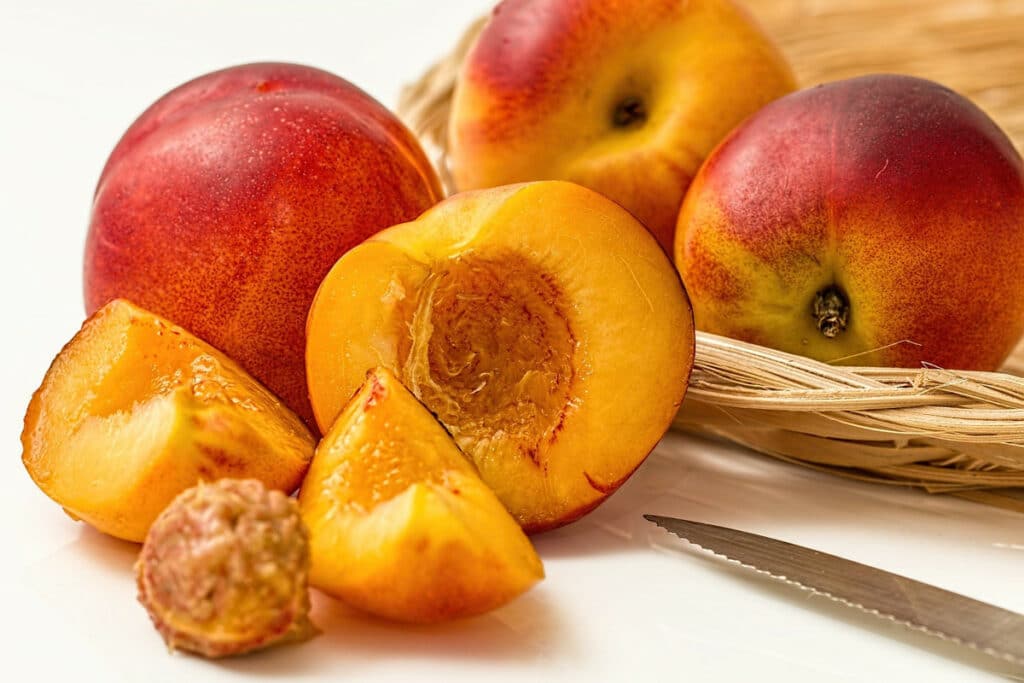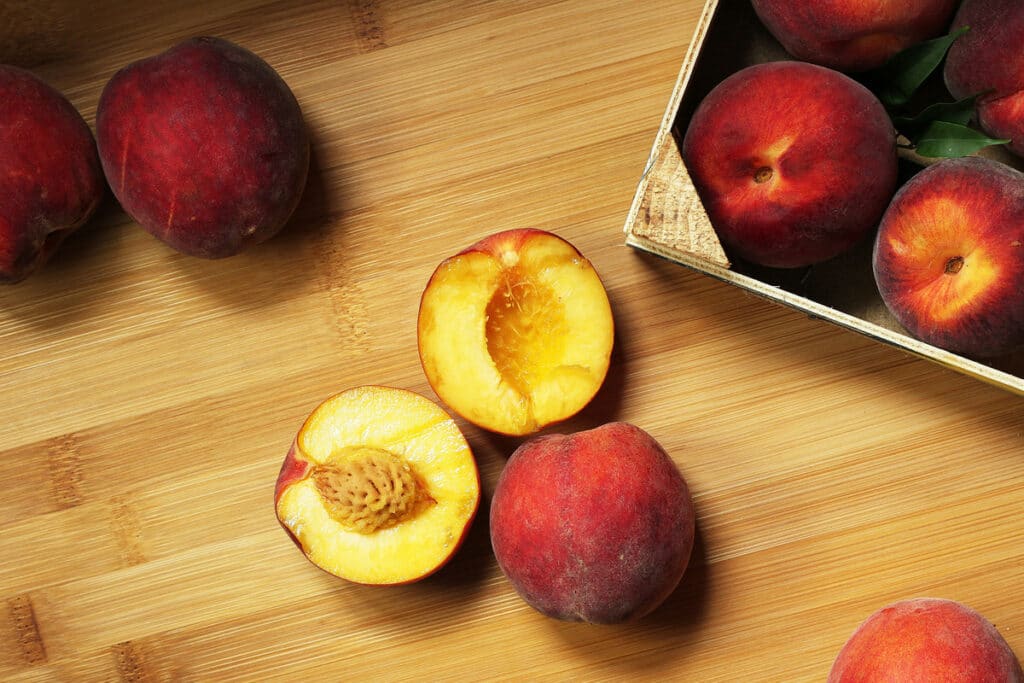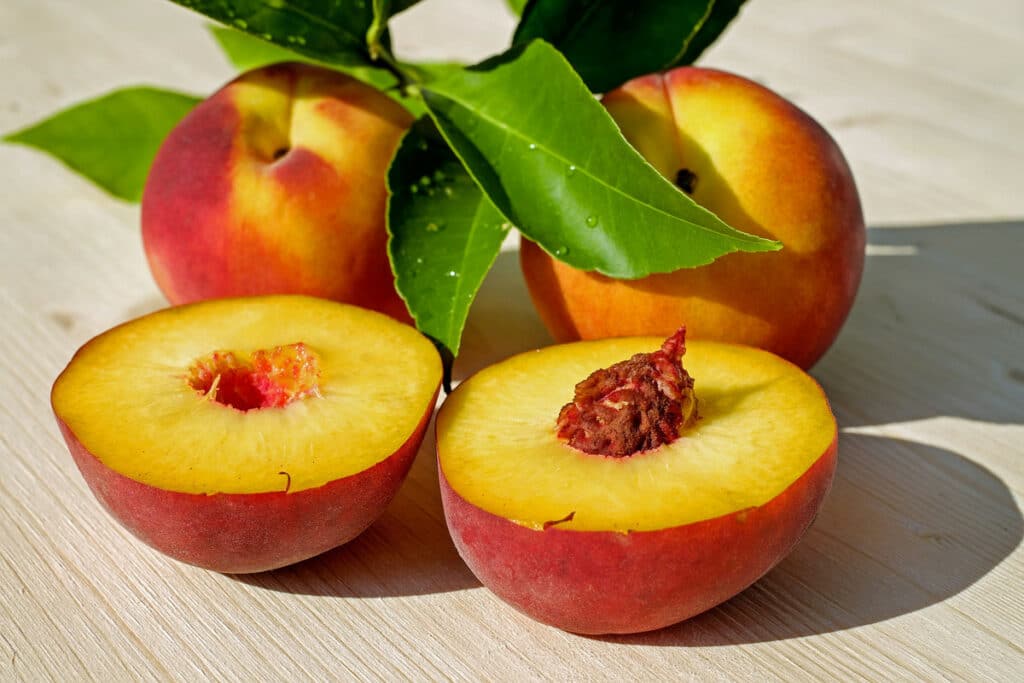
You’d think something as simple as waiting for a peach to ripen wouldn’t require a strategy, but here we are.
I used to leave them on the counter for days, rock hard on Monday, still rock hard on Friday, and eventually just figured it couldn’t be done.
That was back in the day, before I learned the actual techniques that work.
Turns out, learning to ripen peaches properly changed my entire summer fruit game. The methods are surprisingly simple, and once you know them, you’ll never bite into an underwhelming, underripe peach again.
How Peach Ripening Actually Works (Quick + Simple)

Peaches are what fruit nerds call climacteric, meaning they keep ripening after they’ve been picked, just like mangoes and bananas.
The process runs on a plant hormone called ethylene, which sounds like a chemical additive but is actually how fruit talks to itself: “Hey, time to sweeten up.”
Here’s what’s really happening inside that fuzzy skin:
- At harvest, peaches are full of starch and low in sugar.
- As they ripen, enzymes turn starch into natural sweetness and create that signature floral scent.
- Warmth speeds it up, cold stops it entirely.
- Too much heat or moisture? You get mush.
The goal is to give your peaches just enough warmth and space so they ripen evenly, without going from stone to soft mush.
5 Ways to Ripen a Peach (Fastest → Slowest)

Now that you know how peaches ripen, you should know you can’t bully one to sweetness. However, you can nudge it.
Here are the go-to tricks I’ve learned over the years.
1. The Paper Bag Trick (Fast & Foolproof)
This is the internet classic for a reason, and it actually works. Peaches naturally release ethylene gas, and the paper bag traps it close, helping them ripen faster.
What you need:
- A brown paper bag
- 1–2 firm peaches
- Optional: a banana or apple (they release extra ethylene)
How to do it:
- Pop your peaches in the bag.
- Roll the top closed (not airtight, they need to breathe).
- Add a banana or apple if you’re in a hurry.
- Leave at room temperature for 24–48 hours.
Check daily, when the skin deepens in color and the fruit gives gently under your fingers, they’re ready.
2. The Rice or Flour Trick (Overnight Magic)
If you’re impatient, and I mean really impatient, this is your hack.
Submerge the peaches in uncooked rice or flour so they’re completely covered. These grains trap ethylene around the fruit, speeding the process dramatically.
Results: firm peaches turn juicy in about 24 hours.
Caution: Check after the first day. Leave them buried too long and you’ll get soft spots or bruising.
This trick’s been used across Asia for mangoes for decades and it works the same for peaches, just more delicately.
3. The Towel Cradle (Gentle and Even)
For when you want progress overnight but less risk than the rice trick.
Line a bowl with a soft towel, lay your peaches in a single layer, cover them loosely with the other end, and leave them on the counter. The towel traps warmth and protects against bruising while still letting them breathe.
By morning, they’ll usually have softened and started smelling like summer.

4. The Counter Method (Slow, Natural Sweetness)
Sometimes the simplest method wins. Lay peaches on a tray or countertop in a single layer, away from direct sunlight. Flip them once a day.
It takes about 3–4 days, but the payoff is flavor. When ripened slowly, peaches develop deeper sweetness, closer to how they’d taste if they’d finished ripening on the branch.
This is my go-to if I have time. It never fails.
5. The Warm Spot Shortcut (Sunlight, Not Heat)
If your kitchen gets a gentle warm patch near the window, that’s gold. Place your peaches there, indirect light only, and flip them once or twice a day.
They’ll usually be perfect in 2–3 days. Just don’t cook them. Too much sun can cause wrinkled skin or weird soft patches.
You Might Like: How To Ripen Pineapples
How to Tell If a Peach is Ripe? (What Are The Signs?)

Forget color charts, peaches tell you everything if you pay attention.
Let’s look at the most common :
Touch & Feel It
Gently press near the stem, where the fruit softens first. It should give just slightly, like a ripe avocado or the base of your thumb. Too firm means it’s not ready; too soft means it’s slipping past perfect.
It Has a Smell
Bring it to your nose. A ripe peach smells unmistakably sweet, floral, and a little warm, like sunshine. No scent yet? It’s still waiting.
Look
Don’t trust the red blush, that’s just the variety. Focus on the background color under it: golden yellow, not green. A slightly matte finish usually means it’s ready to eat. When those three things
You Might Like: How to Ripen Nectarines

What Not to Do (Learned the Hard Way)
After ruining more peaches than I’ll admit publicly, I’ve learned what not to do:
- Don’t refrigerate unripe peaches, it stops ripening cold. Literally.
- Don’t seal them in plastic, they suffocate and mold.
- Don’t pile them up, the bottom ones bruise before they’re ripe.
Basically: give them warmth, air, and a little personal space. Same advice I’d give most people, honestly.
How to Store Ripe Peaches
Once they’re perfect, slow the clock.
- Whole: Pop ripe peaches in the fridge; they’ll last up to 5 days.
- Cut: Store slices in an airtight container and eat within 2–3 days.
- Freeze: Slice, dip in lemon juice to prevent browning, freeze flat, then bag. Ideal for smoothies or pies.
Take This Peach Energy With You
You’ve got the timing down now, no more biting into and wasting an unripe peach.
Once you start paying attention to how fruit wants to ripen, you’ll see the same patterns everywhere.
So don’t stop here. Head to the Fruit Ripening Hub and learn how to bring every fruit in your kitchen to its best, from slow-starters to overnight miracles.
Your counter’s about to become a produce success story.